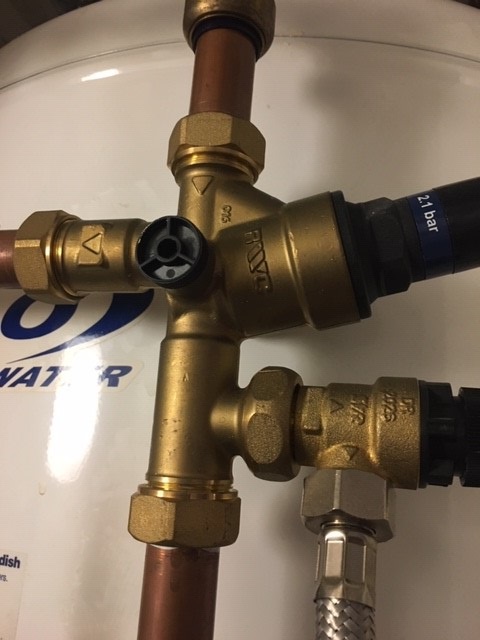- Home
- How to
- How to
- Services
- Services
- Maintenance Plan
- Location
- Guides
- Guides
- No Hot Water – Self help
- Unvented Water Heater
- Unvented Water Heater Faults
- G3 Building Regulations
- Thermal Store Water Heaters
- Thermal Store Faults
- Gledhill ElectraMate
- Gledhill PulsaCoil
- Gledhill Torrent
- Gledhill Stainless Lite
- OSO Unvented Heater
- MegaFlo – Heatrae Sadia
- Santon Premier Plus
- Albion
- Manco Riverstream and Powerstream
- Manco Gladiator & Stirling
- Telford Tempest
- Safety Considerations Unvented Cylinders
- Reduce Your Water Heating Bill
- Range Tribune
- About Us
- About us
- Forum
- Contact

-
Call Now
Specialists in Electric Hot Water Cylinders
What Is a Combination Valve: Understanding Unvented Cylinder Components
Unvented cylinders offer a steady flow of mains pressure hot water at every tap in your home. Gone are the days of dealing with low-pressure water at taps higher in the home or dealing with the maintenance challenges of a vented cylinder.
However, that doesn’t mean that unvented cylinders don’t require maintenance. They do. You should have your unvented cylinder inspected and serviced at least once per year to make sure that it’s in good working order and to prevent unanticipated breakdowns with components, such as the combination valve.
Not sure what a combination valve is or what its purpose might be on your unvented cylinder? Here’s a quick introduction.
What Is a Combination Valve?
A combination valve is designed to streamline the design of your unvented cylinder and make maintenance easier by combining the functions of several valves into a single component. In most cases, combination valves replace the following:
Pressure Reduction Valve – This valve is responsible for reducing incoming water pressure from the mains.
Check Valve – The check valve prevents water from flowing back into the mains from your unvented cylinder.
Expansion Valve – The expansion valve helps protect against overpressure situations and bleeds off excess pressure.
Line Strainer – This stops debris that flows in from the mains from entering the unvented cylinder.
Signs Your Combination Valve Requires Service
The combination valve on your unvented cylinder is a critical component. However, it will eventually need to be replaced. Knowing the signs to look for can help ensure that you’re able to replace it before it fails. Here are a few signs and symptoms of a combination valve that requires a little professional care:
Reduced Hot Water Pressure – This may mean that the line strainer has become clogged with debris and needs to be cleaned or replaced. It may also be a sign that your pressure reduction valve is failing, which will require replacing the entire combination valve on your unvented cylinder.
Leaks – If either the expansion valve or the check valve begins to fail, you’ll notice water running out through the tundish. A failing or failed valve will require a complete combination valve replacement.
Noise – You may hear a hissing sound from your combination valve. This indicates either air in the line or water leaking through the system, which means that the valve must be replaced.
Each of these symptoms indicates a potentially serious problem. If you’ve noticed any of them, get in touch with a qualified plumber immediately.
Who Can Replace Your Combination Valve?
Under UK guidelines, only specific people are licensed to work on unvented cylinders. G3-certified plumbers have the training, experience, and expertise necessary to service, maintain, install, and repair unvented cylinders and their components. Under no circumstances should you attempt to replace the combination valve on your own or hire a plumber without G3 certification.
At EasyFlow, our experienced plumbers have the knowledge, certifications, and tools necessary to handle almost any problem you might experience with an unvented cylinder. We also carry the most commonly required parts with us, which means we can handle your repair and get your hot water back on the very same day.
Iain, Nantwich
13 October 2025
Annual Service
Excellent service as always.. Highly recommendable.
Peter , Nantwich
16 September 2025
Annual Service
Very pleased with all aspects of the work completed by your knowledgeable staff.
Barry, Royton
13 June 2025
Replacement Valves
Tom, Manchester
20 May 2025
Replacement Valves
Raymond, Lancashire
1 May 2025
Annual Service
Vickie, Didsbury
10 April 2025
Annual Service
Raymond, Reddish
17 March 2025
No Hot Water
Brenda , Liverpool
12 February 2025
Installation
Gianfranco, Uk
18 February 2025
Annual Service
As always the serrvice was done efficiently and the surrounding area left clean and tidy.
Anne, Manchester
30 January 2025
Annual Service

© 2025 EasyFlow Water Limited. All rights reserved








Find out what our clients are saying about the services we provide
Click to view